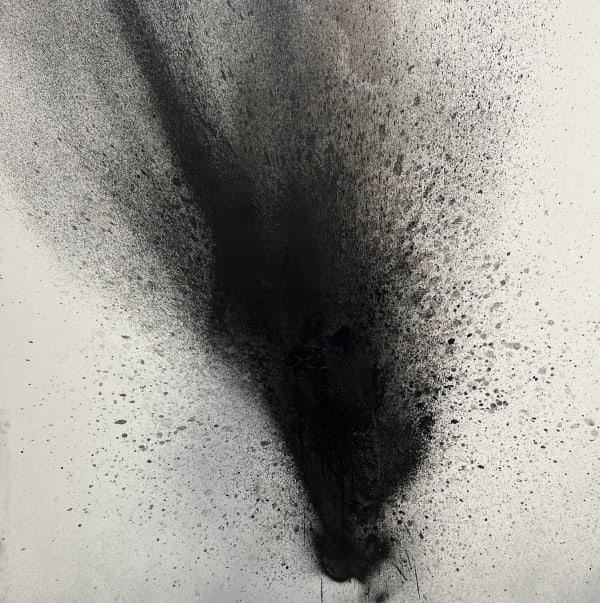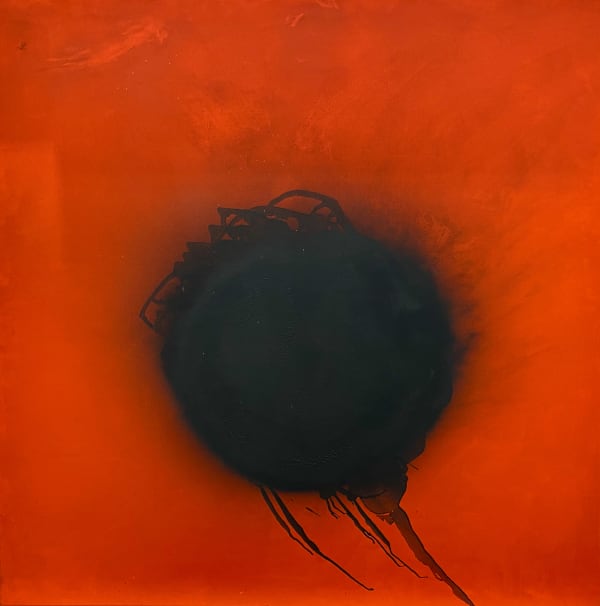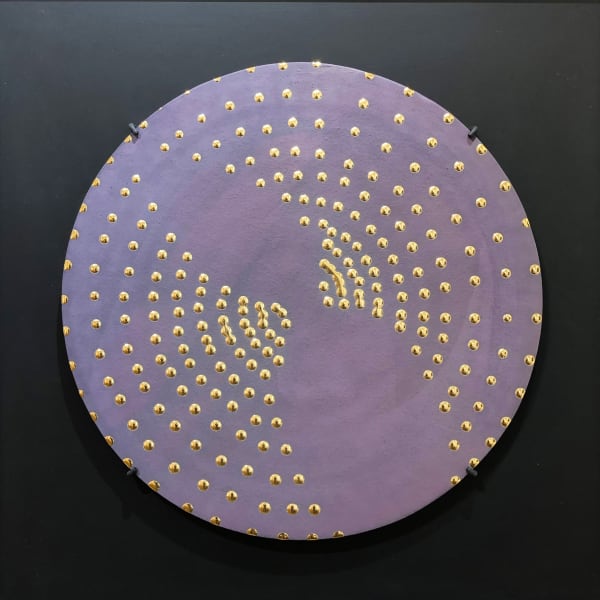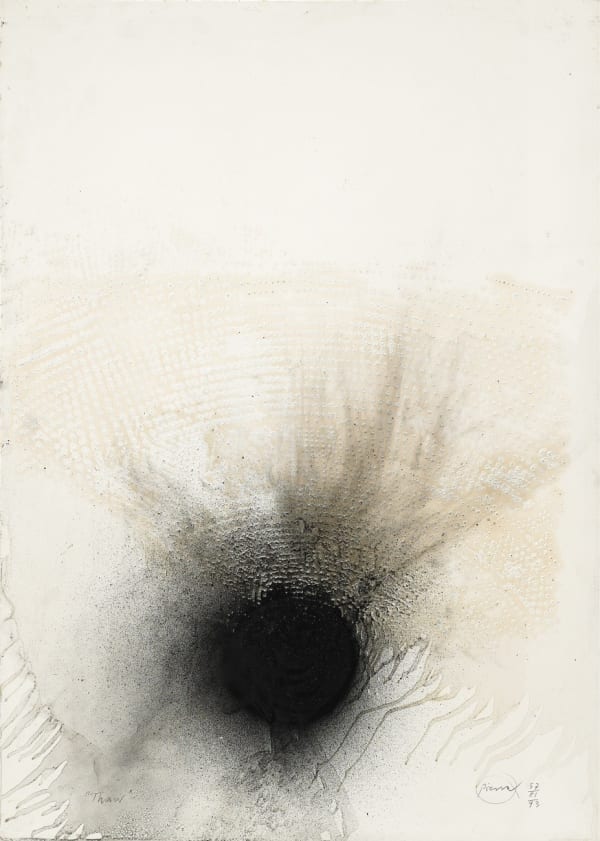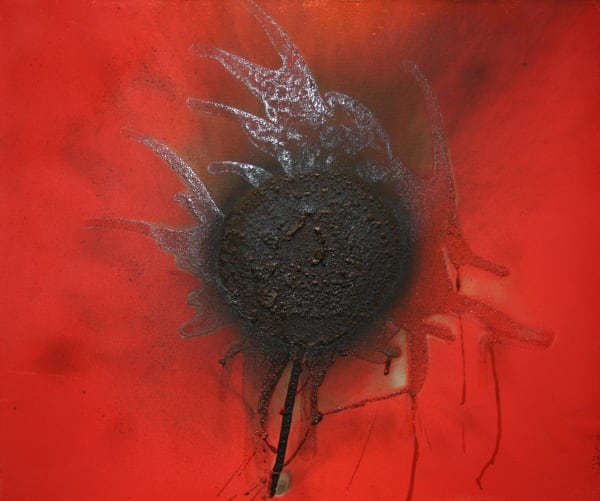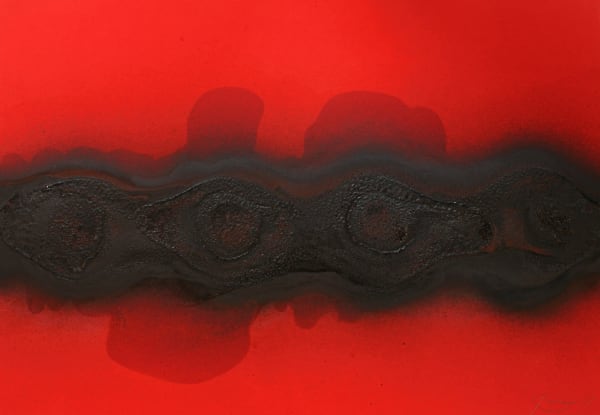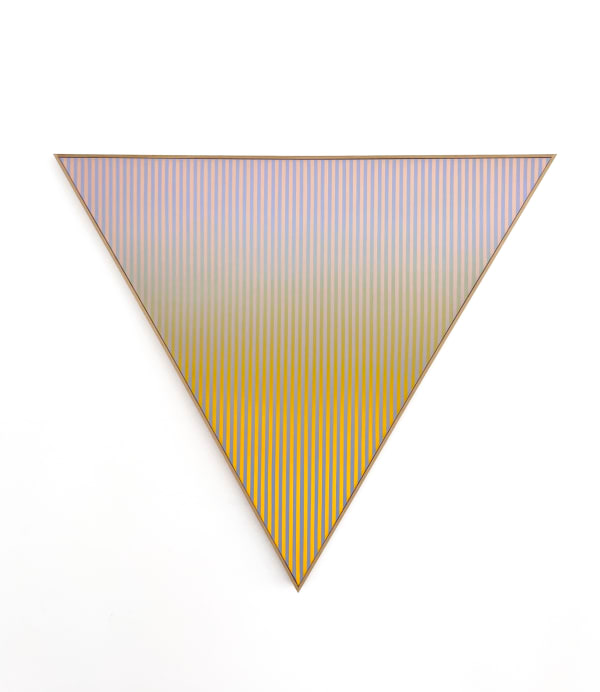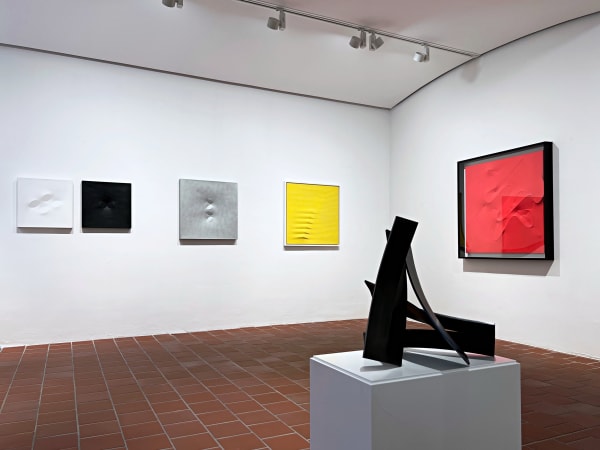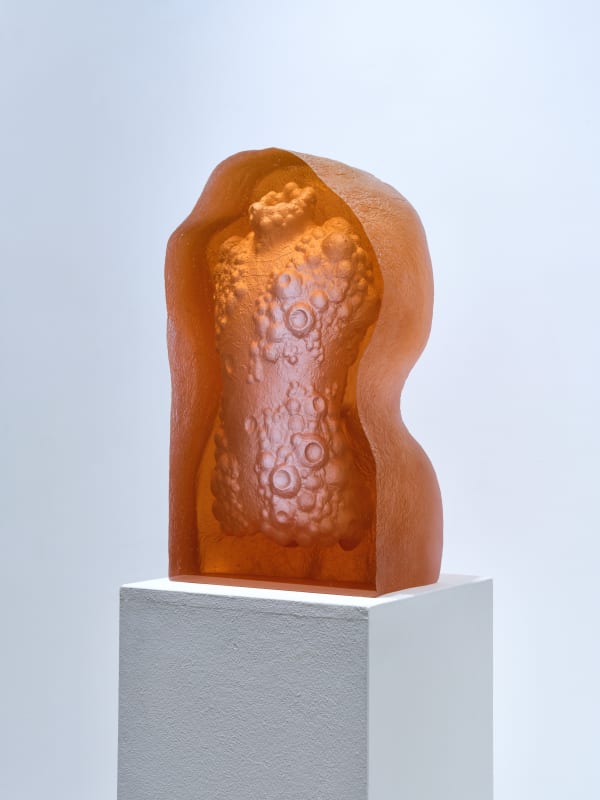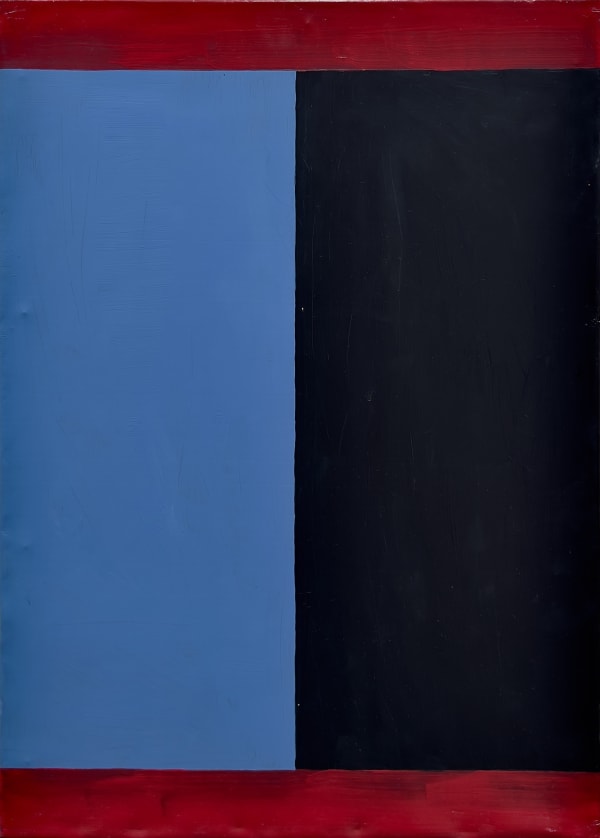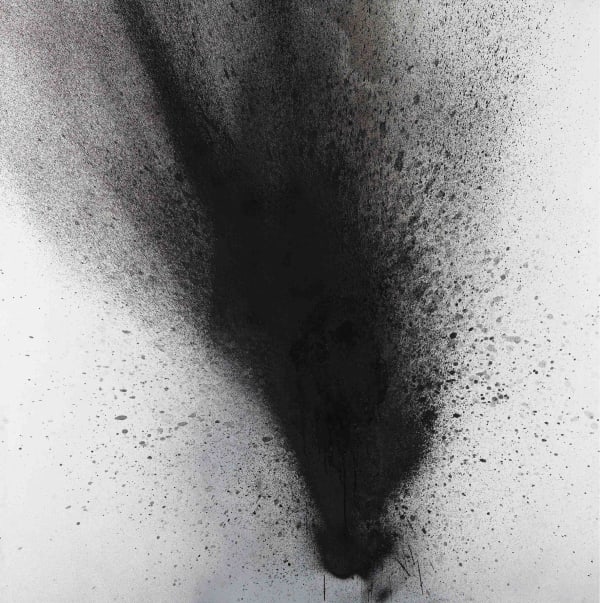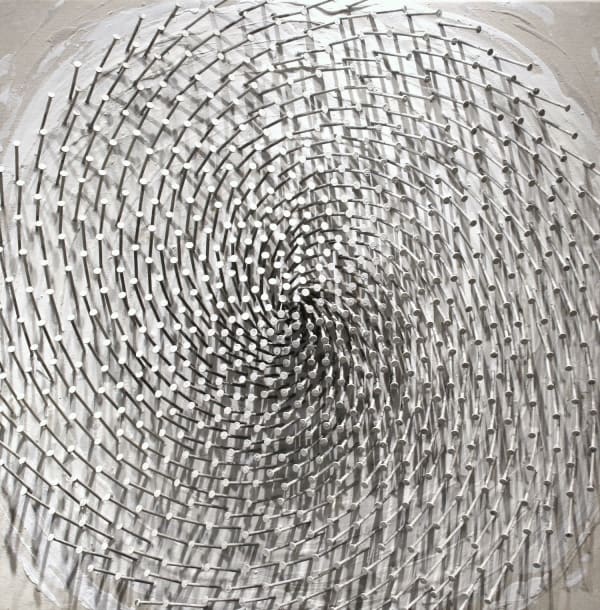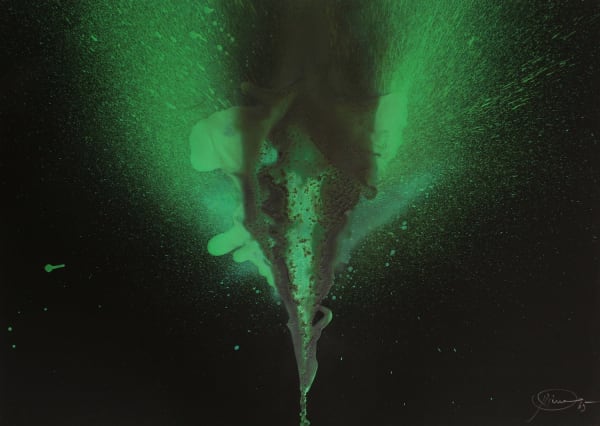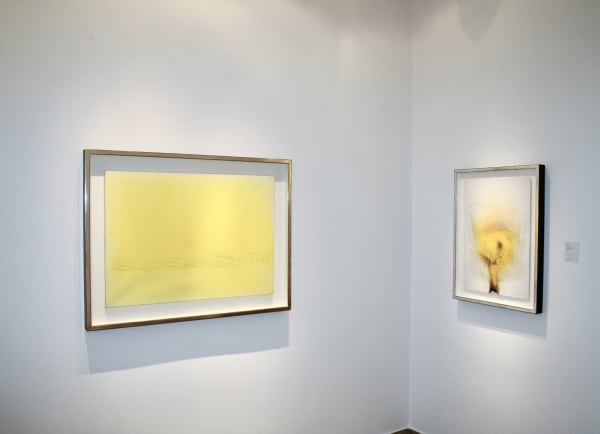Otto Piene German, 1928-2014
What is a painting?A painting is a field of forces, the arena where its author’s impulses all come together, there to be transformed, re-formed into a movement of color. Energies, which the painter has received out of the fullness of the Universe, are now directed into channels opened to the spirit of the onlooker.What is color?Color is the articulation of light.And what is light?Light is the sphere of everything that lives, the element in which the trialogue of painter, painting and spectator must take place; it is caught and intensified into a continuous vibration which contains all three.What is vibration?Vibration is the activity of the nuance, which outlaws contrast, shames tragedy and dismisses drama. It is the vehicle of the frequencies, the life-blood of color and the pulse of light. Vibration is pure emotion and pure energy, that which give the picture its radiance.What is pure energy? The undisturbed continuum, never-ending, unquenchable, the stuff of life. What are they all, painting, color, light, vibration and pure energy? Life. And the free spirit. (Otto Piene, 1959)
Otto Piene (Born 1928 in Laasphe, Germany - 2014 Berlin, Germany)
From 1948-1950, Otto Piene attended the Blocherschule and the School of Fine art in Munich, and then moved to the Art Academy in Düsseldorf. In 1957, he took his state examinations in philosophy at the University of Cologne and worked in art education at the same time. His first grid paintings arose during this period--monochrome structures with partial protrusions that create an irregular relief. Piene organized the first Evening Exhibitions together with Heinz Mack in his studio in the Gladbacher Straße in Düsseldorf that gave rise to group ZERO, which Günther Uecker joined in 1961. Between 1958 and 1961, Mack and Piene published the magazines ZERO 1 through to ZERO 3 containing programmatic texts and, in the third edition, a good deal of visual material with contributions from over thirty artists from the ZERO circle.
Towards the end of the 1950s, Piene performed his Archaisches Lichtballett (Archaic Light Ballet) and developed his first smoke drawings, which were followed by mechanized light sculptures, environments and fire paintings. In 1962, he set up his first Salon de Lumière together with Mack and Uecker on the occasion of the NUL exhibition at the Stedeliik Museum in Amsterdam.Two years later, the joint group ZERO contribution to documenta followed entitled Lichtraum - Hommage à Fontana (Lightspace - Tribute to Lucio Fontana) which was presented in the attic of the Fridericianum. This was one of three appearances by Otto Piene at documenta (in 1959, 1964 and 1977 respectively).
In the course of the 1960s, Piene experimented with multi-media performances as well as with light, smoke, fire and air, i.e. helium sculptures. In 1964, he took up his first visiting professorship at the University of Pennsylvania in Philadelphia; one year later, he moved to New York. At the same time he designed light sculptures for the new theater in Bonn followed by several "Kunst am Bau' Art in Architecture) projects.
In 1968, his first large-scale sky event Light Line Experiment took place with over three hundred polyethylene hoses over three hundred meters-long, illuminated and filled with helium, that seemed to float weightlessly in the sky. A year later, he launched Susan Peters into the sky in Manned Helium Sculpture. In 1974, Pine became Director of the Center for Advanced Visual Studies at the Massachusetts Institute of Technology in Cambridge, Massachusetts, which he duly expanded in the fields of telecommunication, lasers, video, holographs, sky art and environment art. Since the early 1980s, his painting has combined his smoke and fire compositions with the grids from the ZERO period and from 1998 onwards Piene developed light spaces for several museums, including the Kunsthalle Bremen and the Leopold Hoesch Museum in Düren. In his later works, ceramics have become increasingly important, featuring shiny metallic gold and silver glazes, as well as grid-like surfaces. In 1967 and 1971, Piene represented Germany at the Biennale di Venezia; in 1985 he participated in the Bienal de São Paulo. Otto Piene is considered today to be one of the pioneers of light art and sky art.
-

Gallery Selections
2 Apr - 29 Jun 2025Works by Gerhard Richter Günther Förg Otto Piene Heinz Mack Gotthard Graubner Ylva Carlgren Ditte Ejlerskov Roy Lichtenstein Tomas Lundgren Etienne ViardRead more -

Resonant Surface
The Intersection of Light, Color, and Space 5 Dec 2024 - 1 Feb 2025Opening December 5, 5-8 PM MARKUS ÅKESSON, KARIN ALFREDSSON, BERNARD AUBERTIN, GEORG BASELITZ, AGOSTINO BONALUMI, YLVA CARLGREN, PETER DOIG, DITTE EJLERSKOV, GOTTHARD GRAUBNER, RONI HORN, ÅSA JUNGNELIUS, IMI KNOEBEL, TOMAS...Read more -

Art & Design Tegernsee
Art Fair 3 - 6 Oct 2024We are presenting works by Bernard Aubertin, Markus Åkesson, Georg Baselitz, Agostino Bonalumi, Ylva Carlgren, Gotthard Graubner, Roni Horn, Åsa Jungnelius, Imi Knoebel, Tomas Lundgren, Otto Piene, Sigmar Polke, Turi...Read more -

Summer Show
9 Jul - 31 Aug 2024Works by Georg Baselitz, Ylva Carlgren, Gotthard Graubner, Hubertus Hamm, Roni Horn, Åsa Jungnelius, Imi Knoebel, Tomas Lundgren, Maria Miesenberger, Otto Piene, Gerhard Richter, Etienne Viard, Martin Wickström
-

Various Perceptions
Mixed Media 2 May - 30 Jun 2024Works by Georg Baselitz Ylva Carlgren Gotthard Graubner Hubertus Hamm Åsa Jungnelius Imi Knoebel Tomas Lundgren Maria Miesenberger Emil Nolde Otto Piene Bernd Ribbeck Gerhard Richter Dieter Roth Thomas Ruff...Read more -

Winter Show
Full House 30 Nov 2023 - 31 Jan 2024Works by Günther Förg Otto Piene Ylva Carlgren Martin Wickström Tom Wesselmann Imi Knoebel Tomas Lundgren Paolo Scheggi Maria Miesenberger Agostino Bonalumi Michael van Ofen Bernard Aubertin Jean-Luc Moerman Florian...Read more -

Otto Piene
Fire and Brimstone 8 Sep - 9 Oct 2023This exhibition, titled 'Fire and Brimstone,' showcases a selection of Otto Pines most significant series of works, including the "Smoke and Fire Paintings," "Fire Gouaches," "Sky Art," and "Ceramics."Read more -

Summer Show
9 Jun - 30 Jul 2022Imi KnoebelRead more
Tom Wesselmann
Arman
Günther Förg
Dieter Roth
Horst Antes
Anselm Reyle
Magnus Thorén
Olivia Reuterswärd
Hubertus Hamm
Karin Alfredsson
Otto Piene
Günther Uecker
Dadamaino
Agostino Bonalumi
Turi Simeti
-

MULTIFACETED
works from 1960 - 2021 17 Nov 2021 - 27 Feb 2022In our inauguration Exhibition of our new space, we are showing a wide range of works and artists working in multifarious styles and diverse media. The period extends from 1960...Read more -

Abstract - Concrete
Group Exhibition 1 Nov - 23 Dec 2019Works by Otto Piene Walter Leblanc Gerhard Richter Imi Knoebel Günther Förg Turi Simeti Magnus Thoren Anselm Reyle Etinne ViardRead more -

RED
13 Sep - 1 Nov 2014Arman Bernard Aubertin Agostino Bonalumi Lucio Fontana Pino Manos Turi Simeti Pino Pinelli Otto PieneRead more -

Light & Shadow
20 Jan - 23 Feb 2012works by Otto Piene Dadamaino Günther Uecker Adolf Luther How old is light? / Where does light come from? / Who first saw light? / Who last saw light? /...Read more
-

Art Karlsruhe
10 - 13 Mar 2011Works by Otto Piene Gotthard Graubner Günther Uecker Konrad Klapheck Blinky Palermo Gerhard Richter Sigmar PolkeRead more -

Otto Piene
The 50's & 60's 7 Nov - 19 Dec 2007»The Light Paints I wish for a heart with seven cham-bers, and a heartbeat as strong as the tides, and twenty-two lungs to breathe any storm with ease. I wish...Read more



